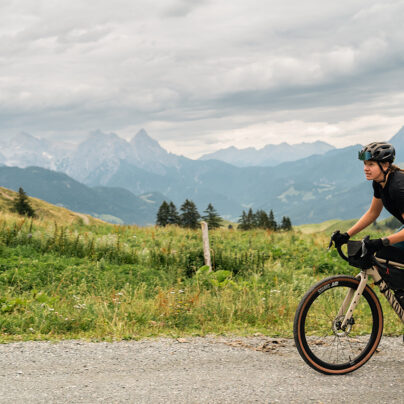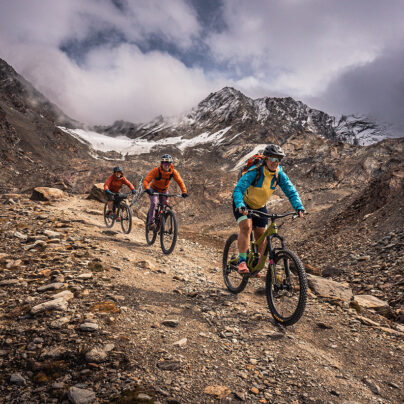Going with the Flow
A Bikerafting Adventure around Islay and Jura
Words and Photography by Aaron Rolph
Planning a trip to explore the Hebrides starts long before the first pedal stroke is taken. The first challenge is getting to the start line. Being a sucker for a point-to-point trip, I find myself woefully lost in 100 browser tabs comparing ferry, train, and local bus times, trying to find the combination that will get me and my bike to Islay, the southernmost island of the archipelago. After an overnight catch-up with a friend in Glasgow’s west end, the stars align and I’m finally pedalling towards the far-out shores of Scotland’s whisky capital, with a big adventure in hand.
Last year, I took on the Outer Hebrides by bike and packraft – a niche adventure discipline affectionately named bikerafting. The concept is simple. Your inflatable raft rolls up to fit neatly onto your handlebars while riding, and when you hit a body of water, your bike perches aboard the raft. Having braved some big sea crossings on that trip, I’m desperate to explore more Scottish islands by this wonderfully self-sufficient human-powered mode of transport.
Pedalling off from the ferry brings a special sense of freedom – I’m now the captain of my own ship, figuratively and literally. After speeding south with a tailwind, energised by a combination of overexcitement and the breathtaking sea views, I soon reach the village of Bruichladdich. I get chatting to the local shop owner and soon we are sitting in the sun enjoying Scotland’s other national drink, an Irn-Bru. He quizzes me about my bikeraft setup, shares tales of his favourite island rides, and points to the best trail to Machir Bay: ‘You need to see this beach,’ he assures me. ‘Sand as far as the eye can see.’ Sounds like the perfect spot for the evening’s wild camp.
After tackling a rough gravel route that follows a coastline of intricate rocky bays and promontories, I’m pushing hard and panting up the final muddy climb. Cresting the top reveals one of the big draws to these beautiful Scottish isles: a mile-long white sand beach with turquoise waters glistening in the soft evening sunlight. And the best bit? With the exception of the Highland cows on the distant hills, I’ve got it all to myself.
It’s been a while since I’ve been on a big solo mission. Much as I’m a social creature, I’ve always found that trips into the wild alone provide a unique opportunity to slow down and reflect. Now, having pitched my tent and eaten some dinner, I can’t wait to get in the water. I wouldn’t call myself a naturist by any means, but it seems rude not to take the opportunity in this quiet spot to go au naturale – and it proves to be exactly as liberating as I imagine. The moment I plunge into the cool Atlantic waters I feel a total sense of calm. The trip can end right now, I think, and I’ll be utterly content.



But my sense of calm doesn’t last long. I wake to a blustery morning – arguably more typical of these wild isles. I follow old farm tracks weaving through the grassy dunes until I make it back onto a patchily tarmacked country lane. At this point my goal is to look at a weather forecast. Not an easy task without phone signal, but I climb the highest hill around and, at length, find a scrap of 4G reception. The forecast suggests that winds are due to pick up throughout the day and into the next. With an open-water raft crossing ahead of me later, I decide that it would be prudent to get cracking. Controversially, I skip visiting any of the 10 distilleries that Islay is famed for – promising myself that I’ll pop into one of my favourites later on in the trip, over on Jura. Let’s hope I can make it.
I’m energised to be riding north, and the heavy load seems manageable under the high-volume tyres of my Salsa. But I’m battling a savage headwind, which is doing all it can to push me backwards. Only after a huge effort do I reach the Sound of Islay, a 1.5km channel of turbulent water that separates the two islands. Where the ferry docks at Port Askaig the wind is tearing down the strait. So, to avoid ending up in Ireland, I ride east before getting on the water – this will compensate for my downwind drift. Now I just need to find somewhere to get into the winter.
Browsing satellite imagery on my phone reveals a boat moored up at a nearby country house. I can’t see it from my location, but I knock on the door and check they don’t mind me jumping into the water from their well-tended estate garden. The yes is immediate, although rather confused – ‘I’m afraid I don’t know where you can safely get to the water,’ the woman tells me. She is not wrong. I find myself fighting through dense forest and bracken, hauling my oversized bike through some seriously questionable terrain until I finally manage to lower it down a sea cliff and onto the rocks below.
Now I understand the lady’s confusion – there’s no boat here. What I took to be a boat on the satellite photo is in fact an old lighthouse, but I’ve got the raft inflated now and it’s time to test the water. Carefully avoiding scores of jellyfish, I push off. It feels good to be finally paddling at sea. I keep an eye on points along the shore to assess my progress – not only forwards but also sideways in the wind, which I feel as an insistent pressure on my body. As expected, I’m being blown down the sound. I land at a large sheltered beach 4km west of where I was aiming for, but this doesn’t matter – I have a whole new island to explore.
Though not dissimilar in size to Islay, Jura has a different character. The skyline of the island is dominated by impressive peaks called the Paps – which is an Old Norse word for breasts, and a curious name given that there are three, but no judgment on our Viking cousins here. To the west and north there are notoriously rough seas along with the world’s third largest whirlpool, the Corryvreckan. Rich forests bridge the peaty uplands and flourishing seas. It is an island resonating with the sounds of nature.



Navigating Jura is easy – there is only one road, enough to service the 200-strong population. Arriving at Craighouse, the largest village on the island, I take some time off the bike to explore the distillery and catch up on some all-important calories at the hotel. Before my second sip of Guinness, I’m chatting to local residents Jerry and Jan who insist they had no alternative but to move here, all in the pursuit of alliteration. ‘You either get Jura or you don’t,’ the warm couple explain. They go on to share their experiences of island life and point out some of the colourful characters who pass and wave. After more pints than I care to remember, it’s time to find tonight’s camp spot high in the hills.
According to my vague itinerary, the plan was to paddle to the mainland today. But, with brutal easterly winds persisting, there’s zero chance I can make it – and besides, there is still so much to see on Jura. Instead, I decide that going with the flow is the best option and spend a bit more time exploring this intriguing island. Riding north, the road gradually deteriorates to almost nothing and I decide to aim for a bothy on the opposite coastline, one I’d been wanting to visit for some time now. Crossing these boggy, pathless hills won’t be possible by bike, so I pack what I can into my backpack and continue by foot.
The atmosphere is textbook moody Scotland. A bar of grey cloud clings to the rolling hills. Persistent rain keeps me cool on an otherwise mild day. Having been warned of especially high sightings of adders this year, the UK’s only venomous snake, I keep a close eye on where I’m standing in my open-toe cycling sandals. And, after a couple of hours of wading through wet moorland, I begin dropping down to a pristine bay where the bright white walls and vibrant orange roof of the bothy stand as a beacon in a landscape of pastel tones. It feels like a special, secluded place. Time to light the fire. Then I crack open the bottle of 18-year-old Jura I’d picked up in the distillery, feeling fortunate indeed to have this amazing place all to myself.
Next morning, I hit some phone signal again and get a message from long-standing adventure buddy Ed, who says the weather looks good for an attempt on the Cuillin Ridge tomorrow. ‘How quickly can you get back?’ I do some mental gymnastics. It would take some time for me to get back down to get the ferry to the mainland, but an opportunity to traverse Skye’s fabled Cuillin doesn’t come about often. After checking some detailed forecasts, I decide that the wind might temper enough to attempt the 10km crossing back to mainland by packraft.



Reading tidal charts doesn’t yield much insight into the overall ebb or flow of the channel. Setting off an hour before slack water will give me the best chance of a trouble-free crossing, I decide, and after readying my kit, and securing the bike on my inflated raft as best I can, I begin paddling out into the deep. Concerns are quietly spinning around in the back of my mind. What if the boat lets air out? What if the tides are so strong I’m pushed out to the open sea? But this is no time for doubt. If I’m honest, it is in these very moments I feel most alive. It’s just me, my blow-up boat, and the unknown of the adventure ahead.
The wind seems manageable, but I don’t let myself relax for a moment. Just like before, I visually assess movement against various landmarks – but this time my senses are heightened, because I know this is a more serious crossing. After an hour or so I realise that I must be nearing the halfway point. In both directions the horizon feels a long way away now. The swell’s really starting to pick up, and all at once I feel exposed – I’m a tiny speck in what feels like an endless ocean. But any real worries have been washed away. I can’t wipe the smile off my face, even though the skies are almost as dark as the inky waters and waves are crashing overboard. My boat is being wrestled side to side in the swell. I can make out detail on the mainland sea cliffs. They’re close. The final upwind battle feels relentless until I finally reach a sheltered bay where I can crash down onto the beach.
Bikerafting big routes gives you an unbeatable sense of self-reliance. If the conditions are right, and if you are bold enough, little can stop you – land or sea. This fine line between commitment and danger is a key part of its appeal, but it also means that mistakes can be consequential. You’ll always be second to the power of nature. So be prepared to go with the flow.
Words and photography by Aaron Rolph // @aaronrolph
The British Adventure Collective // @britishadventurecollective // britishadventurecollective.com
Produced in partnership with Exped // @expedint





